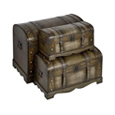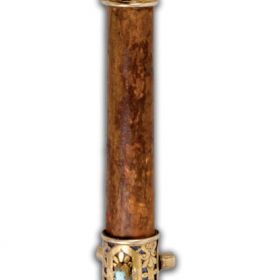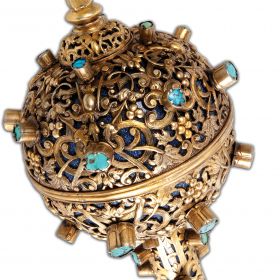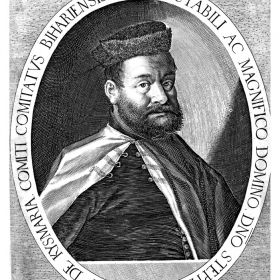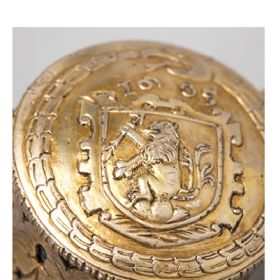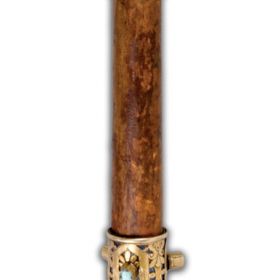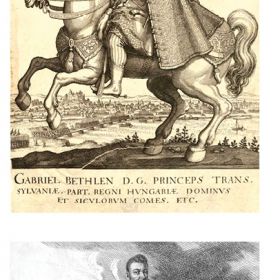Sceptrul principelui Ștefan Bocskai
Text: Alexandra Mărășoiu; photo: Marius Amarie
The scepter, which is of the mace type, is made of wood and consists in a spherical head and a handle. The head is covered in blue enamel and then plated with gilded silver, with vegetal motifs fretwork. The metal was cast as two hemispheres, joined in the middle of the head by a band on which two engraved initials can still be seen; they probably belonged to the craftsman: an “H” inscribed in a “C”. On top of the head, there is a small downward-facing hemisphere, also covered in enamel and gilded silver fretwork, surmounted by a gilded silver arrow tip. On the upper, medium and lower part of the handle, which used to be partially wrapped in velvet, there is a sleeve with the same decoration as that of the head (blue enamel and metal sheet fretwork). On the end of the handle, the coat of arms of the Bocskai family is engraved in flat relief in a rectangular shield with a pointed base, surrounded by a dragon with its tail coiled around its neck and a rampant lion placed towards the left, holding in its left paw an arrow pointing upwards.
The organization of the Principality of Transylvania under Ottoman suzerainty. The scepter – an Ottoman investiture insignia
From the 11th to the 16th century, the voivodship of Transylvania (territorially corresponding to the Transylvanian Plateau), the north-western part of Romania and the Banat belonged to the Kingdom of Hungary. Things changed after 1526, when the Hungarians suffered a serious defeat in the battle of Mohacs against the Turks. Because the Hungarian king Louis II died in the battle and had no heirs, the crown of Hungary was disputed by his brother-in-law, Ferdinand of Habsburg, archduke of Austria (who, in 1558, became a Roman-German emperor) and the Prince of Transylvania, John Zapolya. The latter was supported by the Sublime Porte, which, after his death, acknowledged his son, John Sigismund, born in 1540, as the King of Hungary. As, two years before, Zapolya had signed with Ferdinand of Habsburg the treaty of Oradea, through which he appointed him as his successor, the archduke of Austria tried to remove John Sigismund from power, which led to the military campaign launched by Suleiman the Magnificent in 1541. Following this campaign, the center and the south of Hungary were conquered and turned into a pashalik. The north-western areas of the former kingdom remained under the Habsburgs’ control, whereas the eastern ones (Transylvania, the Banat and Partium – the north-western territory of Romania nowadays) remained in John Sigismund Zapolya’s power. Three decades later, in 1570, through the treaty of Speyer, signed with the emperor Maximilian II [the son of Ferdinand of Habsburg, king of Hungary since 1563 and emperor since 1564], John Sigismund gave up his title of king, in return being acknowledged as a “prince of Transylvania and parts of Hungary” [the phrase “parts of Hungary”, namely Partium, no longer referred to the Banat, which was conquered by the Ottomans in 1552].
Thus, John Sigismund was the first prince of Transylvania. After him, although there were exceptions, such as the case of Stephen Bocskai, which will be discussed below, the rule was that the princes of Transylvania had to be elected by the representatives of the privileged classes of the officially recognized nations (Hungarian, German and Szekely) and then confirmed by the Sultan. Just like the leaders of other states that were tributary to the Sublime Porte, the princes of Transylvania used to receive several symbols of power when they were invested. The main ones were the imperial diploma (berat-i hümayun), the flag (sancak) and the robe of honor (kaftan), but others could be added, such as a headwear with panache (hil’at, kuka), a girdle (kemer), one or several horses (at), a scepter (topuz) and a sword (saif).
In some contemporary engravings, as well as on the effigies on some minted coins, the Transylvanian princes are depicted holding a scepter. However, only some of these scepters have been preserved. Besides the one of Stephen Bocskai, owned by NMRH, there are other four at the National Museum of Hungary (the ones belonging to Sigismund Bathory, Stephen Bathory, George Rakoczi II, John Kemeny), one at the Museum of Art History in Vienna (Michael Apafi’s) and one at the Museum of Transylvanian History (the one belonging to George Rakoczi II; it was purchased in 2015 from a private collector).
Prince Stephen Bocksai
Stephen Bocskai enters the Transylvanian history when his nephew (his sister’s son), Sigismund Bathory (1586), was elected Prince. As he was his nephew’s close adviser, he was appointed the county head of Bihor and the commander of the army. Bocskai, who was in the Habsburgs’ service during his youth, encouraged Sigismund Bathory to guide his policy towards them and to let Transylvania participate alongside the Habsburgs in the Austrian-Turkish war, which had broken out in 1593. However, after Transylvania got under the control of the imperial general Gheorghe Basta (August 1601), Bocskai protested against the violent acts committed by his troops and this is the reason why he was held in detention in Prague for two years by the imperial authorities. Afterwards, he retired to his estates in Bihor County. In 1604, in the context of the Counter-Reformation initiated by the Habsburgs in Hungary, which implied that the Catholics took over some Protestant churches and confiscated some estates of the Hungarian nobility, who was mostly Protestant, some nobles required the Sublime Porte’s support against the Habsburgs. They attracted Bocskai on their side, aiming at obtaining the agreement for him to become the Prince of Hungary. Led by Bocskai, the rebellion broke out in the autumn of 1604 in Bihor County and started with a great victory of Bocksai’s troops, made up of outlaws and frontier soldiers, over the imperial troops (the 15th of October, Almosd). The rebels managed to occupy the north-east of the Hungarian kingdom (some territories that are currently in Hungary and Slovakia) and, in November 1604, Bocskai got from Sultan Ahmed I the “berat” [diploma] for being appointed the Prince of Transylvania and Hungary. In this capacity, on the 12th of December 1604, he was writing to the people in Bistrița County, in order to inform them on the following: “as, with God’s help, we have managed to bring our action to a successful conclusion, we leave everything here [...] and we want to go there, among you, as if in our country, and to take it under our control as well, because we took the mighty and undefeated emperor’s mace and flag both for Transylvania and for Hungary.” Indeed, as he had pledged to do, in the first half of 1605, Bocskai managed to remove the imperial troops from Transylvania. During the same year, the titles received from the Sultan in 1604 were confirmed at the national level: on the 21st of February, Bocskai was elected the Prince of Transylvania by the Szekely congregation reunited in Miercurea Nirajului, on the 20th of April, the Diet of Hungary in Szerencs elected him the Prince of Hungary and, on the 14th of September, in Mediaș, he was elected the Prince of Transylvania by the Diet of the privileged classes. Moreover, on Bocskai’s request, expressed by his messengers in Constantinople, on the 19th of May 1605, Sultan Ahmed I gave him an “ahdname” (an imperial letter of pledge), through which he guaranteed him support and help against the enemy, in exchange for his and his subjects’ loyalty towards the Sublime Porte, and acknowledged him as the king of Hungary and the ruler of Transylvania – two dignities that he could pass on to his successors. The second “ahdname” was issued for Bocskai at Sarospatak, in October 1605. The Ottoman chroniclers Ibrahim Pecevi, Kiatip Celebi and Mustafa Naima say that, due to Bocksai’s victories over the Habsburgs, the grand vizier Lalla Mohamed promised him that he would be crowned King of Hungary, which the Sultan approved. The coronation ceremony took place on the Rákos plain, near Buda: Bocksai came with an army of 10000 people and the grand vizier placed on his head a crown decorated with precious stones, which was worth 3000 gold pieces [nowadays in the patrimony of the Art History Museum in Vienna], girded him with a sword inlaid with precious stones and gave him an imperial flag. Nevertheless, according to his poet laureate, Ioan Bocatiu, who participated in the event, Bocskai accepted the crown only as a gift and declared that he did not want to infringe the rights of the king of Hungary [Rudolf II, who was also the Roman-German emperor]. In fact, at that time, Bocskai was interested in signing a peace treaty with the imperial authorities, which happened in the summer of 1606. The peace treaty signed in Vienna on the 23rd of June 1606 guaranteed the freedom of religious belief to the Protestants in Hungary and acknowledged Bocskai’s control over the Principality of Transylvania, as well as his possession over the Tokay castle and the counties of Ugosca, Bereg and Satu Mare, which he had conquered during his rebellion. A few months later, the provisions of the treaty of Vienna were included in the one that put an end to the Austrian-Ottoman war started in 1593 (the peace treaty of Zvistvatorok, the 11th of November 1606). After a short while (the 29th of December 1606), Stephen Bocskai died, and the Ottoman chronicler Mustafa Naima considered that he had been poisoned by the Habsburgs. However, some poems dedicated to Bocskai after his death indicate Chancellor Mihail Katay as the murderer, who was lynched by the prince’s soldiers.
The coat of arms of the Bocksai family
Through a diploma issued on the 19th of March 1408, Sigismund of Luxembourg conferred to “Andreas filius Nicolai filii Thomae de Chap”, one of his courtiers and a knight of the Order of the Dragon [founded by the king on the 14th of December 1408, in order to defend the Christian faith, symbolized by a cross, against the enemies, symbolized in the emblem of the order by a dragon], the following noble coat of arms: on a blue shield, a gold lion rampant, holding in its right forepaw an arrow that penetrates its right eye and surrounded by a dragon with a red cross on its back and with its tail coiled for three times around its neck; this coat of arms could also be used by Andreas de Chap’s relatives, among whom there was “Joanni de Bachko”, a forerunner of the Bocskai family. Regarding the coat of arms used by Stephen Bocskai, it is worth mentioning that the cross on the back of the dragon is missing, and sometimes the arrow held by the lion in its right forepaw is pointing upwards (e.g. the coat of arms on the scepter and on some coins minted during his reign).









